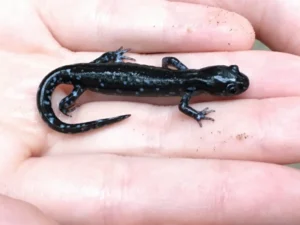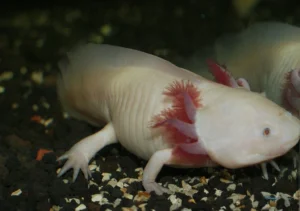Salamanders are quiet, secretive animals with smooth skin and slow, careful movements. Some people are drawn to their peaceful behavior and unique looks. If you’re thinking about keeping one, you may wonder: do salamanders make good pets?
Yes, salamanders can make good pets for the right kind of person. But they need special care and are not animals that like to be held or played with. They are best for people who enjoy watching quiet animals in a calm setting.
Why Some People Choose Salamanders as Pets
There are a few reasons why salamanders appeal to certain pet owners. They are very quiet and do not make noise.
Unlike birds, dogs, or even frogs, salamanders stay silent. This makes them a good match for small apartments or shared living spaces where noise can be a problem.

They are also low-maintenance in some ways. Once their tank is set up correctly, salamanders do not need constant attention.
You do not have to walk them, groom them, or entertain them. They mostly take care of themselves.
Another benefit is their size. Salamanders do not need much room. Most species live happily in a small tank that fits on a shelf or desk. This makes them a good choice for people with limited space.
Some salamanders live a long time. With proper care, many can live for 10 years or more. While this is a big commitment, it also means you can enjoy their presence for many years.
Many people find salamanders relaxing to watch. They move slowly and often hide during the day. At night, they come out and explore. Their gentle behavior can be peaceful and calming.
What Kind of Care Salamanders Need
Even though they are quiet and small, salamanders have special care needs. Their health depends on their environment. To keep one as a pet, you must create a space that feels like their natural home.
Moisture is one of the most important needs. Salamanders have thin skin that must stay damp. They breathe through their skin, so if it dries out, they can get very sick.
Their tank needs to stay humid. Most owners spray the tank once or twice a day with water to keep it moist.
Temperature is also important. Salamanders do not like heat. Most species do best at room temperature or cooler.
You should keep their tank away from windows, heaters, or any spot that gets too warm.
The tank floor needs a soft, moist material called substrate. This can be soil, coconut fiber, or damp moss.
It should hold moisture without being soaking wet. Salamanders often dig into this material to stay cool and safe.
They also need hiding places. In the wild, salamanders hide under rocks, logs, or leaves. In a tank, you can use pieces of bark, caves, or upside-down flower pots. The more places they can hide, the less stressed they feel.
Some species need a small water dish to soak in. Others, like aquatic salamanders, need a full tank of water to swim in.
The setup depends on the type of salamander you choose. In all cases, the water must be clean and free of chlorine.
Do Salamanders Like to Be Held?
One of the most important things to understand is that salamanders do not like to be touched. Their skin is delicate and can absorb harmful substances from your hands. Even clean hands can pass along oil or lotion that can damage their skin.

Salamanders also become stressed when handled. They are shy by nature and do not enjoy being picked up.
If you must move one, it’s best to use a soft net or wear wet gloves. Always keep handling short and gentle.
Because of this, salamanders are not good pets for young children. They are better for adults or older kids who are happy to watch but not touch. If you want a pet that enjoys cuddling or playing, a salamander is not a good fit.
Salamanders That Are Good for Beginners
If you are new to keeping salamanders, it helps to start with a species that is hardy and easier to care for.
- Tiger salamanders are one good choice. They are large and strong, and they can handle small mistakes in care. They like to dig and are fun to watch, especially during feeding time.
- Fire salamanders are another option. They have bright yellow and black patterns and do well in cool, damp tanks. They are calm and tend to stay in one place, which makes them easy to care for.
- Axolotls are a special kind of salamander. They never leave the water and stay in their larval form all their lives. They need an aquarium instead of a land tank. Many people like their feathery gills and smiling faces. Axolotls are widely available and there is lots of care information for them.
If you’re just starting, avoid rare species or those with complex needs. Begin with a healthy, common salamander and learn more as you go.
What Are the Challenges?
Salamanders can be great pets, but they are not right for everyone. There are some challenges you should think about before getting one.
- First, they are not interactive. Salamanders do not respond to voices or show affection. They do not bond with people or want attention. If you want a pet that feels like a companion, a salamander may not be what you’re looking for.
- Second, salamanders can escape. They are quiet, soft, and good at slipping through small gaps. If the tank lid is not secure, they might get out. A salamander loose in a house is hard to find and may not survive.
- Third, keeping the temperature just right can be tricky. If your home gets very hot in summer or very cold in winter, you might need a cooler or heater to keep their environment stable.
- Feeding can also be a problem for some people. If you don’t like bugs or worms, keeping live food in your house may not be enjoyable. Salamanders need insects or other small animals to eat.
Also, most salamanders are active at night. They often hide during the day and move around after dark. If you are only home during the day, you may not see much of them.
What Kind of Tank Is Best?
Not all salamanders live the same way. Some live in water, some on land, and some need both. The kind of tank you need depends on the species you choose.
Aquatic salamanders, like axolotls, need a full tank of water. This setup is similar to a fish tank. The water must be cool, clean, and filtered. It needs to be changed often to keep the salamander healthy.

Land salamanders need a tank with moist soil or moss. They also need a shallow water dish where they can soak. The tank should be covered to hold in moisture and prevent escape.
Some species need part land and part water. These setups are called paludariums. They can be harder to build, but many people enjoy creating natural-looking spaces with rocks, plants, and flowing water.
No matter the setup, the tank must have a tight lid. Salamanders are quiet and flexible. They can squeeze through small openings and disappear without a sound. A strong lid keeps them safe and holds in the moisture they need.
What About Laws and Safety?
Before you buy a salamander, check the rules in your area. Some places don’t allow salamanders as pets. Others may allow only certain species.
This is to protect wild salamanders and prevent the spread of disease.
Some salamanders are protected in the wild. Taking them from nature can hurt the population. In many places, it’s also illegal.
Salamanders can carry a fungus that spreads to wild amphibians. Moving salamanders between areas can pass the fungus along.
This is another reason why some regions have strong laws about keeping them.
You should never collect a salamander from the wild. Always buy from a legal breeder or pet shop. This helps protect wild animals and gives you a healthier pet.
Conclusion
Salamanders can make excellent pets for people who know what to expect. They are quiet, low-maintenance, and interesting to watch.
They take up very little space and do not need much attention. For those who enjoy calm animals and nature, they can be a great match.
But salamanders are not for everyone. They do not enjoy being touched, they are most active at night, and they require a specific kind of care.
If you want a pet that shows affection or plays with you, a salamander may not be right.
Before you decide, take time to learn about the species you want. Make sure you can meet their needs and follow any local rules. And remember, a salamander is a living creature that depends on you for everything.
Hi, my name is Ezra Mushala, i have been interested animals all my life. I am the main author and editor here at snakeinformer.com.

